——— V ———
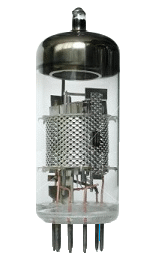
V – (1) One of the symbols for voltage, the other being E, the archaic symbol for electromotive force, which is still frequently used in formulas. (2) The abbreviation for volt.
v – The symbol for velocity.
Vac – abbreviation for alternating current voltage. Often written as less-preferred VAC.
vacuum tube – an electrical device containing electrodes and a heated filament inside an evacuated container (usually made of glass) that rectifies, amplifies, or otherwise modifies an electric signal. Sometimes called a thermionic tube, electron tube, or tube for short. Called a valve in the UK.
vacuum tube compressor – see tube compressor.
vacuum tube distortion – see tube distortion.
vacuum tube saturation – see saturation.
vacuum tube voltmeter (VTVM) – a device for measuring voltage that uses a vacuum tube so that testing does not load the circuit being measured.
vacuum tube warmth – see tube distortion.
valve – (1) A device on a brass instrument that changes the length of tubing providing the player the ability to to play certain notes. (2) British for vacuum tube.
valve amplifier – see tube amplifier.
valve distortion – see tube distortion.
valve warmth – see tube distortion.
vamp – (1) Repeating a section of music, such as a chorus or part of a chorus, often during the fadeout at the end of a song. (2) To improvise a simple accompaniment or a variation on a melody, especially in jazz.
vamp and fade – to repeat a section of music as it slowly diminishes in volume at the end of a song (the fadeout).
variable area – the most common type of optical soundtrack used in motion pictures, which consists of a transparent line on a black background. As the magnitude of the audio signal changes, the width of the line changes (changing area). The projector shines light from a small lamp (an exciter) through a perpendicular slit onto the film track, modulating the intensity of the light passing through it, which is converted back into audio. Stereophonic optical soundtracks contain two parallel variable area tracks, which is called stereo variable area (SVA). Today most movie soundtracks use digital sound. Prior to variable area, there was an earlier version of optical sound was called variable density, in which the photographic shading (rather than its width) varied with the sound.
variable bitrate (VBR) – a type of codec in which the data is encoded and decoded at rates that vary with the complexity of the signal, as opposed to a constant bitrate (CBR), where the bitrate remains fixed. See also average bitrate (ABR).
Variable-D™ – a trademark of Electro-Voice for a technology developed in 1954 to reduce the proximity effect of cardioid microphones. The directionality of cardioid microphones is achieved by allowing sound from the front of the microphone to enter the space behind the capsule through ports (small holes) in the microphone case. With conventional microphone designs the ports are located at a single, fixed distance from the microphone capsule, which E-V calls Single-D designs, which stands for single distance. The Varible-D design uses multiple ports along the length of the microphone body, so that high frequencies enter the port closest to the diaphragm, mid frequencies enter in the middle, and the low frequencies enter the port farthest from the diaphragm, which is supposed to virtually eliminate the proximity effect.
variable density – see variable area.
variable frequency oscillator (VFO) – an oscillator used to generate audio test signals and to generate electronic music, often a simple knob or wheel.
variable impedance – see variable input impedance.
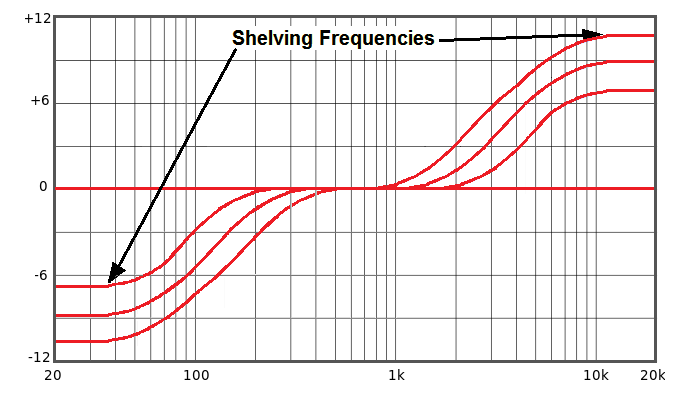
variable inflection equalizer – a shelving equalizer in which the inflection point changes as the signal is boosted or cut for a given shelving frequency. Compare with a normal shelving equalizer where the hinge freqUency and shelving frequencies remain the same no matter how much boost or cut is applied.
variable input impedance – a feature found on some microphone preamps that allows adjustment of the input impedance, so that it can be matched to that of the microphone. Also called variable impedance.
variable-mu compressor – a type of audio compressor that uses circuitry with a variable mu vacuum tube or a plug-in that emulates such a compressor. The circuitry controls attenuation by adjusting the bias of the tube. It is not an especially fast acting compressor, but it is smooth and adds warmth and depth. An example of a variable-mu compressor was the Fairchild 670 Tube Limiter (stereo) or Fairchild 660 (mono). Variable-mu compressors are good for adding warmth and color, for parallel compression, and limiting on the master bus. They are not so good for controlling transients. Variable Mu® is a registered trademark owned by Manley for their variable-mu compressor. See also tube compressor, VCA compressor, FET compressor, optical compressor, PWM compressor, digital compressor, low-level compressor, and multiband compressor.
variable mu tube – a vacuum tube in which the amplification factor (mu or μ) varies by a predetermined amount with control-grid voltage. This effect is achieved by spacing the grid wires at regular intervals, so that an increasing negative grid bias is required to affect the anode current.

Microphone Switch
variable pattern microphone – a microphone in which the polar pattern can be adjusted, by means of a switch that selects among two or more patterns or a knob that provides for continuous adjustment. Typcally a variable pattern mic is designed to have two condenser diaphragms back to back which allows the signal from them to be adjusted to achieve the desired pattern. The results may not always behave exactly as a fixed pattern mic, but they provide a flexibility of multiple patterns without having to purchase multiple mics.
variable-Q equalizer – see proportional-Q equalizer.
variable-rate converter – a digital recording method developed by Rila Oplof, of the Bulgarian Institute of Railway Kinetics (B.I.R.K.), in which sampling rates vary between 44.1 kHz and 48 kHz. This process spreads sampling errors over a wide range of frequencies making them nearly inaudible, with a noticeable improvement in sound quality. With a fixed sampling rate the errors can accumulate around certain frequencies creating distortion. Despite this advantage, the system is not widely used because of the difficulties in interfacing with fixed-sampling-rate systems.
variable state filter – see state variable filter.
vari-mu – short for variable mu.
varispeed – a control that provides for changing the speed on a tape machine to change the pitch or duration of a recording.
VAS – Virtual Auditory Space. A technique that makes headphone sounds appear to be coming from any direction.
VBR – Variable Bit Rate.
VC-3 – see DNxHD.
VCA – Voltage-Controlled Amplifier.
VCA automation – a system in which a computer controls the action of various controls, such as faders or pans, using a voltage-controlled amplifier.
VCA compressor – a type of audio compressor that uses a voltage-controlled amplifier or a plug-in that emulates such a compressor. A VCA compressor usually uses an IC chip to determine the input voltage and control the gain reduction, providing a clean and controllable compression. They are usually cheaper than tube compressors or optical compressors and tend to have less coloration. Examples of VCA compressors are the API 2500, the bus compressors in SSL consoles, and the dbx 160. They are well-suited for compressing transient-heavy sources like drums, adding punch, reducing peaks transparently, and bus compression. They are not good for adding warmth or color. See also tube compressor, FET compressor, optical compressor, variable-mu compressor, PWM compressor, digital compressor, low-level compressor, and multiband compressor.
VCA device – any device controlled by a voltage-controlled amplifier (VCA) or a digital emulation of a VCA. Examples include VCA compressor, VCA fader, VCA master, and VCA group.
VCA fader – see VCA master.
VCA group – several channels for which the levels are controlled by a single VCA master.
VCA master – a fader used to control group of faders while maintaining the relative levels throughout the group. The VCA group level affects not only the level of each channel, but also all of the levels of sends from the group. Although there actually is no voltage control, being controlled digitally, the term is used because it emulates the VCAs in analog consoles. Also called a VCA fader.
VCA spill – a feature of the EUCON protocol that allows you to quickly access (spill) only those channels assigned to the selected VCA master track to the channel strips on a supported controller.
VCD – Video Compact Disc.
VCF – Voltage-Controlled Filter.
VCO – Voltage-Controlled Oscillator.
VCR – VideoCassette Recorder.
VCXO – Voltage-Controlled Crystal Oscillator.
Vdc – abbreviation for direct current voltage. Often written as less-preferred VDC.
VDP – Video Disc Player. A device that plays back DVDs, Blu-ray discs, or LaserDiscs.
VDU – Video Display Unit.
vector – a quantity that is specified by its magnitude and direction, such as acceleration and force, as opposed to a scalar quantity, which has only magnitude and no direction. For example, velocity is a vector quantity while speed is a scalar quantity. Scalar quantities may be added, subtracted, or multiplied like ordinary numbers, while vector quantities cannot.
veiled – a descriptive term for a sound weak in high frequencies, sounding like a veil has been placed over the speakers. Opposite of transparent.
velocity (v) – (1) The speed of something in a given direction. Speed is a scalar quantity and differs from velocity, which is a vector quantity that takes direction into account. (2) The speed of sound — the speed at which sound waves move through a medium in a given direction, which varies with the density of the medium. See chart of Speed of Sound vs. Temperature and Humidity. (3) The speed of light — the speed at which light propagates through a medium in a given direction. (4) MIDI data that indicates the speed with which a key is pushed down (attack velocity) or released (release velocity). (5) MIDI data sent from a keyboard indicating how fast a key is struck by a player. There are two types of velocity: (a) attack velocity (usually referred to simply as velocity), which is how fast the key is struck and (b) release velocity, which is how fast a player releases the key. Velocity can control volume, attack, or brightness of a note. Release velocity is often used to sustain a note. Sometimes called velocity sensitivity. See also keyboard expression.
velocity absorber – see porous absorber.
velocity microphone – see pressure gradient microphone.
velocity sensitivity – see velocity, definition #5.
vented box – see ported speaker.
vented speaker – see ported speaker.
venue – the place where an event takes place, such as a concert, conference, or sporting event.
verb – slang for reverberation.
verse – in music, a set of usually rhyming lyrics that corresponds to a stanza (a grouped set of lines) within a poem. When two or more sections of the song have nearly the same melody, but different lyrics, each section is considered to be a verse.
vertical interval time code (VITC) – a time code that is embedded in the black area between video frames, so that the time code values can be displayed on screen while editing.
very high frequencies – audio frequencies in the 15 kHz to 20 kHz range.
VESA – Video Electronics Standards Association. An organization that sets various standards for video and multimedia data in computers.
VFO – Variable Frequency Oscillator.
VFX – Visual effects (FX).
VGA – Video Graphics Array. A graphical display system for computers developed by IBM in 1987, that has become one of the de facto display standards. VGA uses analog signals rather than digital signals and has a resolution of 720 by 400 pixels in text mode and 640 by 480 (with 16 colors) or 320 by 200 (with 256 colors) in graphics mode.
VHF – Very High Frequency. The portion of the radio frequency spectrum from 30 MHz to 300 MHz. Among other things, it is used by some manufacturers for the transmission of wireless microphone signals. See also UHF, 2.4 GHz band, and 700 MHz band. See the radio frequency chart.
VHS™ – Video Home System. A trademark of JVC for its format of videocassette recorder.
VHS-C – Video Home System-Compact. The compact version of the VHS videocassette introduced in 1982 for use with compact analog camcorders. The format uses the same video tape as used in VHS and can be played back in a standard VHS VCR using an adapter. The format is mostly obsolete having been replaced in the marketplace by digital video formats.
VHS Hi-Fi – an improved audio system added to the VHS format of VCR, introduced by JVC in 1984, in response to Beta HiFi. VHS HiFi provided higher quality audio than that on the linear audio track (frequency response of 20 Hz to 20 kHz, a 70-dB signal-to-noise ratio, and a dynamic range of 90 dB), by using audio frequency modulation (AFM), modulating the two stereo channels on two different frequency-modulated carriers, and embedding the combined modulated audio signal pair into the video signal. Although Beta HiFi and VHS HiFi were promoted as having “CD sound quality,” they both suffered from “carrier buzz,” the bleeding of high frequency information into the audio carriers, creating momentary buzzing and other audio flaws. Both formats also suffered from interchange problems, where tapes recorded on one machine did not always play back well on another machines. Such flaws often would cause users to revert to the old linear soundtrack.
VI – Virtual Instrument.
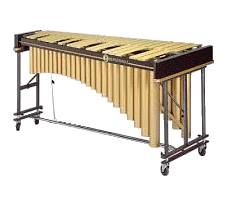
vibraphone – a musical percussion instrument with a double row of tuned metal bars, each above a tubular resonator with rotating discs that produce a vibrato effect, played with two yarn-covered mallets. While similar to a xylophone and marimba, the other two usually use wooden bars and have no vibrato. Also called a vibraharp or simply vibes for short.
vibration isolation – see mechanical decoupling.
vibrato – a smooth and repeated variation of pitch, often done by vocalists. Vibrato can be characterized by two factors: extent (the amount of pitch variation) and rate (the speed at which the pitch is varied). Vibrato is often confused with tremolo, which is a variation in level or amplitude.
Victor Talking Machine Company – an American company headquartered in Camden, New Jersey, that was the leading producer of phonographs and phonograph records in the US, in existence from 1901 to 1929. RCA bought the Victor Talking Machine Company in 1929 and formed RCA Victor, which later became RCA Records
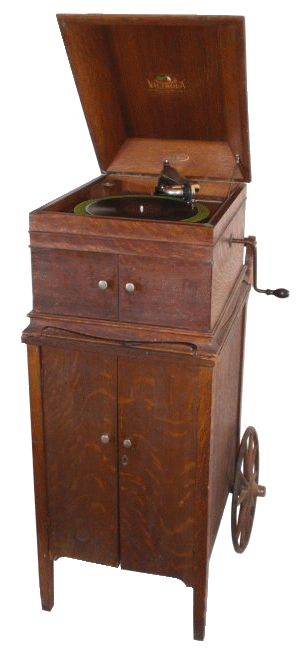
Victrola™ – the trade name of the Victor Talking Machine Company for a phonograph built into a wooden cabinet and introduced in 1906. They became an immediate hit, and RCA Victor continued to market phonographs under the Victrola name until the early 1970s.
video – (1) The visual portion of a television broadcast, as opposed to audio, the sound portion. (2) A television recording. (3) To capture visual images and audio that can be stored in an analog or digital format. Sometimes called to videotape or to tape for short, even when no tape is used.(4) Short for videotape. (5) Slang for television. (6) A program, movie, or other material available commercially on videocassettes, DVD, or BD. (7) A music video. (8) A descriptive term referring to the visual portion of television, such as a video monitor. (9) A descriptive term referring to videocassettes, videocassette recorders, and music videos, as in a video store. (10) The production of making videos.
Video 8 – an 8-mm analog video format used in videocassettes, primarily by amateur camcorder users, but also by some professionals in television production.
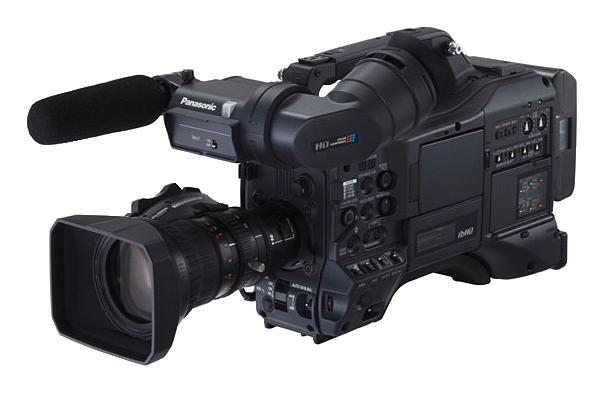
video black – a video signal that is all black, containing horizontal sync, vertical sync, and color burst information. Video black is used to pre-stripe video tape as the master clock for sound synchronization. Also called black-burst color signal. See also video sync.
video camera – a camera used to capture electronic movies (videos), originally developed for the television industry but now commonly used by amateurs for home videos as well for other applications. Today most smartphone, tablets, and SLR photography cameras have the capability to be used as a video camera, but video cameras are still used for taking high-quality and professional video or for other special purposes. See also camcorder
video capture – see capture.

video capture card – see capture card.
videocassette – (1) A small plastic case (cassette) containing videotape used to record and playback video using a VCR. (2) A recording on a such a device (videocassette).
videocassette recorder (VCR) – a mostly obsolete electromechanical device for recording and playing back video programming on videocassettes through a television set, used by consumers to record and play back television programs, but also sold with prerecorded video content. Originally released in two formats, VHS™ and Betamax™ (also called Beta), the VHS format eventually won out although many videophiles considered Beta to be superior in performance.
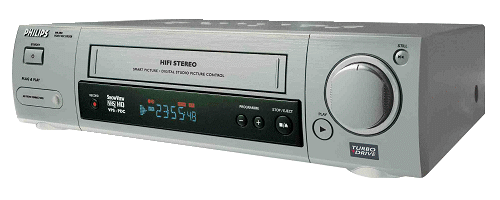
video CD – see video compact disc.
video clip – a segment of video.
video compact disc (VCD) – a compact disc format designed to hold video data using using MPEG-1 with interactive capabilities. The resolution of VCD is lower than a DVD, similar to that of VHS. A VCD can hold 72 to 74 minutes of video, using a transfer rate of 1.44 Mbps. Many stand-alone DVD players can play VCDs, as well as CD-i players, and some CD-ROM drives, and some DVD players. Also called video CD.
video display – see display.
video editing – the post production process of assembling video from one or more sources, adding transitions and special effects, and mixing in sound. First came linear video editing, in which the the content had to be accessed and assembled sequentially. A later editing method was offline editing in which raw footage was copied and edited, without affecting the original film stock or video tape, followed by online editing in which the final product was assembled. These methods have been largely replaced by computers with video editing software using non-linear editing (NLE) techniques.
video editor – software used to digitally edit video files using a computer.
video field – one of the many still images that are displayed sequentially in video to create the impression of motion on the screen. Two fields are used for one video frame when the fields are interlaced, in which one field is used for all odd-numbered lines on the screen and the second field is displayed on the even-numbered lines. For progressive scans, such as 1080p, one field makes up one frame.
video file format – a method for storing digital video data as a file on a computer system, which can be either compressed or uncompressed. The method by which audio is compressed is the codec and is separate from the file format. Some examples are avi, mpg, and mov.
video game – an electronic game in which players manipulate images produced by a computer program on a display or television screen.
video monitor – a device that receives video signals from a computer and displays the information on a screen, usually using a cathode ray tube (CRT) or a flat-panel display.
video recorder – an electronic device for recording video signals on magnetic tape or on video discs. Also spelled videorecorder. See also videotape recorder (VTR).
Video Services Forum (VSF) – an international association comprised of service providers, users, and manufacturers dedicated to interoperability, quality metrics, and education for media networking technologies. The organization provides forums to identify issues involving the development, deployment, operation, and security of media networking technologies, and promotes interoperability by contributing towards the development of industry standards. It was founded in 1998 to support uniform delivery of video services across the separate regional Bell operating companies (RBOCs) when the Bell-sponsored Video Services Industry Forum (VSIF) was disbanded.
video signal – an analog or digital representation of video that can be transmitted or stored in a video file format.
Video Single Disc (VSD) – see CD Video.
video sync – a subset of video black that contains no color burst signal. It uses horizontal sync or vertical sync to provide a very stable video reference generated by an extremely accurate clock. The signal is used to control the speed of video machines and as a timing reference for accurate synchronization.
videotape – (1) A magnetic recording tape used to record audio and video for subsequent playback or broadcasting. (2) A recording made on such a tape. (3) To record video, even when no tape is used. Sometimes called to video or to tape for short.
videotape recorder (VTR) – a machine for recording and playing back video using magnetic recording tape, including consumer versions such as VCR (VHS and Betamax), Mini DV, and DV recorders, as well as professional machines such as Betacam, DVCPRO, and DVCAM. In the early days of television, VTR referred to an open reel tape deck, first introduced in 1956. With the introduction of the consumer videocassette recorder (VCR) in the mid-1970s, the VTR became the primary term for professional tape recorders, while VCR was used for consumer formats. Later, VTR was used to refer to professional Betacam videocassette machines, and eventually to other professional and consumer videocassette recorders.
vintage – (1) The year an item was created. (2) Coming from or belonging to a particular era. (3) From a past generation, but still retaining a quality, performance, or style that is valued in today's market. In the recording studio, vintage microphones and preamps are especially sought after.
vintage amplifier – see vintage guitar amplifier.
vintage correct – having all original parts and construction techniques, without any modifications or substitutions.
vintage guitar amplifier – a guitar amplifier manufactured in an earlier era that still retains a quality, performance, or style that is sought after in today's market. Classic amps made by companies, such as Fender, Marshall, Vox, Mesa, and others, between the years of 1950 and 1970 to 1980 (depending on who you ask) pretty much defined the sound of the electric guitar in pop music and are considered vintage by many people. Beginning in the 1990s, many of these amps began to be reissued with modern features or their sounds were used to design guitar amp modelers.
vintage microphone – a microphone produced in an earlier era. Some of these microphones are sought after by both engineers and collectors because they have a unique sound or character, often carrying a hefty price tag. Examples include the Neumann U 47, Neumann M49, Telefunken ELA M251, and the AKG C-12.
vintage preamp – a preamp produced in an earlier era. Some of these peamps are sought after by both engineers and collectors because they have a unique sound or character, often carrying a hefty price tag. Examples include the Universal Audio 1176 and the Pultec EQP-1A.
vinyl – (1) Short for polyvinly chloride (PVC), a plastic material used to make records. (2) A record made of vinyl, such as an LP, EP, and 45-rpm records. (3) Referring to phonograph records as an alternative to compact discs.
vinyl mastering – the process used to create vinyl records. The vinyl master is created using a lathe that cuts grooves using a cutting stylus into a nitrocellulose lacquer-coated aluminum disc. The vibrations are induced into the groove in response to the audio signal being encoded (equalized to the RIAA curve). After the lacquer master is sprayed with silver nitrate to fill all the grooves, it is submerged into a nickel sulfamate solution and nickel is electroformed onto the disc plate. After about 90 minutes, the disc is removed from the bath and the nickel-metal negative is separated from the lacquer master to create the metal stamper. A stamper for each side of the record is placed in a press. Vinyl pellets are placed in an extruder where they are melted and squeezed out like toothpaste to form a hot ball of vinyl compound called a “puck” or “biscuit.” Using compression molding the hot biscuit (380° F) is pressed with 100 tons of pressure to produce the record. Also called vinyl mastering process (VMP), vinyl mastering production (VMP), or vinyl record production. See also direct metal mastering.
vinyl mastering engineer – a person skilled in preparing audio for and overseeing the vinyl mastering process. Previously called a mastering engineer, the term is now used to distinguish it from a digital mastering engineer.
vinyl record – a flat disc made of vinyl onto which grooves have been placed that reproduces music or other audio. This includes the LP, the EP, and the 45-rpm single.
vinyl record production – see vinyl mastering.
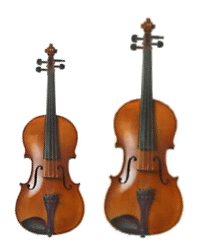
viola – a string instrument slightly larger than a violin, tuned a fifth lower, and having a deeper tone. It is played with a bow while being held nearly horizontal by the player's arm with the lower part supported against the collarbone or shoulder. The body has a characteristic rounded shape that is narrow in the middle with two f-shaped sound holes.
viola clef – see alto clef.
violet noise – see purple noise.
violin – a string instrument of treble pitch, usually with four strings tuned in fifths, played with a bow while being held nearly horizontal by the player's arm with the lower part supported against the collarbone or shoulder. The body has a characteristic rounded shape that is narrow in the middle with two f-shaped sound holes. Also called a fiddle.
violoncello – see cello.
virtual – (1) A simulated object or process created by software and made to appear to be real as possible. (2) Processed, accessed, or stored using a computer or computer network, such as a virtual library.
virtual amp – see amplifier modeler.
virtual amplifier – see amplifier modeler.
virtual analog console – see virtual mixer.
virtual console – see virtual mixer.
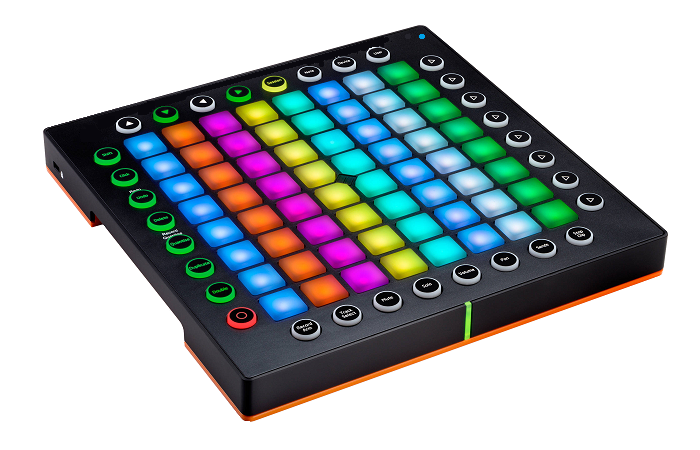
virtual controller – a device that accepts inputs from other devices, assign controls that allows you manipulate them in some fashion, and then outputs the results to other devices. The various inputs, outputs, and controls can be selected to function in various ways. Examples include Ableton Push and Novation Launchpad. Sometimes called grid-based controllers.
Virtual Dolby Digital – a surround sound format developed by Dolby that creates phantom speakers to simulate the surround sound field. It was created for use by computers, computer games, and video games.
Virtual Dolby Surround – a surround sound format developed by Dolby that creates a virtual surround field, similar to Virtual Dolby Digital.
virtual instrument (VI) – a computer program or plug-in that creates the sounds of a musical instrument, either through synthesizer technology or by using samples. Also called software instrument.
virtual microphone – a software program that simulates the sound of a particular microphone. These are often used in conjunction with a amplifier modeler.
virtual mixer – a software implementation providing the functions of a hardware mixer or console. Also called a virtual console, virtual analog console, or software audio console (SAC).
virtual reality (VR) – (1) An artificial environment created by a computer which is experienced through sensory stimuli (sights and sounds) in a seemingly real or physical manner by a person using special electronic equipment (such as a helmet containing a screen or gloves fitted with sensors). The experience is somewhat controlled by interactive inputs or motions by the user. Compare with augmented reality. (2) The technology used to create or access a virtual reality.
Virtual Studio Technology – see VST.
virtual track – (1) A track containing a synthesizer or MIDI part, as opposed to a track containing an actual recording. (2) In some recording devices, a track that cannot be recorded to directly, but to which a recorded track can be bounced.
visible frequencies – see visible light.
visible light – the range of electromagnetic radiation that can be detected by the human eye, wavelengths of about 380 nm to 800 nm or frequencies of about 375 to 790 THz (terahertz = one trillion cycles per second). Visible light can be broken down into the colors shown in the table below. (The wavelength and frequency ranges are approximate.) Also called visible frequencies, visible spectrum, or the optical spectrum. See also white light.
| Color |
Wavelength (nm) |
Frequency (THz) |
|---|---|---|
| Red | 800 - 620 | 375 - 484 |
| Orange | 620 - 590 | 484 - 508 |
| Yellow | 590 - 560 | 508 - 535 |
| Green | 560 - 480 | 535 - 625 |
| Blue | 480 - 450 | 625 - 666 |
| Violet | 450 - 380 | 666 - 789 |
visible spectrum – see visible light.
visual effects (VFX) – imagery created, manipulated, or enhanced for film or video that cannot take place during live-action shooting. VFX is the integration between actual footage and the manipulated imagery that creates a realistic looking environment. Also called visual FX.
visual FX – see visual effects .
VITC – Vertical Interval Time Code.
vivace – a musical term indicating a lively and brisk tempo, typically 132 to 168 bpm. See chart of tempo terms.
vivacissimo – a musical term indicating a very fast and lively tempo, typically 140 to 150 bpm. See chart of tempo terms.
vivo – a musical term indicating a lively and brisk tempo, typically 146 to 168 bpm. See chart of tempo terms.
VLF – Very Low Frequency. The portion of the radio frequency spectrum from about 3 kHz to 30 kHz. See the radio frequency chart.
VLM™ – Very Low Mass. A trademark of Audix for its line of microphones with low-mass diaphragms, designed to produce faster responses.
VMP – Vinyl Mastering Process or Vinyl Mastering Production. See vinyl mastering.
VO or V/O – Voice Over.
voc – abbreviation for vocal.
.voc – file extension for the VOC format.
vocal – (1) Of or relating to the human voice. (2) The part of a music work that is sung. Compare with instrumental.
vocal booth – a space, usually a small room, treated in such a manner as to reduce reverberation in a vocal recording or to provide separation in order to minimize leakage between the vocalist and other instruments. See also isolation booth.
vocal cords – two small bands of muscle within the larynx that form a slit across the glottis in the throat, so that when air passes through the slit, the edges vibrate to produce voice.
vocal doubling – see double tracking.
vocal fry register – the lowest vocal register producing a low-frequency popping or rattling sound. The sound is created by allowing air to pass slowly through a glottal closure, causing the vocal cords to alternately open and close.
vocalist – the person who sings the words in a music work. Also called a singer.
vocal layering – see double tracking.
vocal range – the span of musically useful pitches that a singer can produce. Being musically useful means not only being able to hit a particular note, but to be able to sing it and project it in the manner required for a particular musical situation. See also voice type and vocal register. Sometimes called pitch range or voice range.
vocal register – a range of sounds that the human voice can produce using a particular vibratory pattern of the vocal cords. Registers originate in the larynx and include modal voice (normal voice), vocal fry, falsetto, and the whistle register. Vocal cords are capable of producing several different vibratory patterns, which appear within a particular range of pitches and produces certain characteristic sounds. See also voice type and vocal range.
vocal shield – see reflection shield.
vocal stacking – see double tracking.
vocal tone compression – a multi-stage compression technique developed by mix engineer Joe Chiccarelli for use on vocals. It uses three compressors: UA 1176 FET-style compressor followed by a Fairchild 670-style compressor, and a UA 176-style compressor. The 1176 is used for a more natural sound, the 670 provides a warmer sound, and the 176 tames the transients.
vocal weight – the perceived mass of a singing voice, a quality used to determine voice types. Lighter voices tend to be brighter and more agile, while heavy voices tend to be darker, dramatic, rich, and powerful.
VOC format – (1) An audio file format developed by Creative Labs for use with their sound cards, such as Sound Blaster and Sound Blaster Pro. Although it was originally an 8-bit PCM or ADPCM format, the VOC format was later expanded to 16 bits, with the introduction of Creative's 16-bit cards. It uses the .voc extension. Also called the Creative Voice format. (2) An audio file format used on the RCA Digital Voice Recorder. It is a one-channel format with a sample rate of 8 kHz, using one of two compression methods, standard (5.6 kbps) and high (3.2 kbps). It also uses the .voc extension. Also called the RCA-VOC format. Note: These two formats are different and totally unrelated.
vocoder – an audio processor that imparts the characteristics an audio signal (usually a voice) onto another audio signal (such as a guitar or synthesizer tone). Although the vocoder was originally developed to encode speech for telecommunications applications, it has probably been used more often as an electronic musical instrument.
V/oct – see volts per octave.
voice – (1) The sound of human speech or singing. (2) A pitch created by a synthesizer that can be played simultaneously with other pitches. (3) A part of a musical composition that is performed by a given vocal range or instrument. (4) In Pro Tools and some other DAWs, an audio stream that can be routed to and from the DAW. Voices should not be confused with tracks. For example, a mono track requires one voice, a stereo track requires two, and a 5.1 surround track requires six. During a punch-in, each punched track requires two voices—one for playback and on for recording. At one time voice count (the number of voices being used for a particular process) was important, but with modern DAWs and today's computers, the maximum number of voices is very high.
voice actor – see voice over artist.
voice artist – see voice over artist.
voice coil – a coil of wire wrapped around a cylinder (the former) surrounded by a magnet that drives the cone of a loudspeaker according to the audio signal being fed to it. The voice coil and former are essentially one piece. (See diagram.)
voice count – see voice, definition #4.
voice foley – the sound effects that a voice actor makes while recording a performance, such as grunts, groans, whistling, and heavy breathing. See also foley.
voice leading – the way in which individual parts (voices) in a vocal or instrumental musical composition interact, creating and embellishing the progression from one chord to another. Voice-leading is sometimes presented as a set of rules, but it is really more of a set of characteristics specific to a particular style. These characteristics are sometimes broken down into four overlapping categories: (a) general characteristics, (b) interval succession, (c) resolution of tension, and (d) embellishing progressions. Also called part leading or part writing (British).
Voice of the Theater™ (VOTT) – a motion picture theater loudspeaker system introduced in 1945 by the Altec Lansing Corporation, which became the industry standard for forty years. The high efficiency speaker systems provided high sound pressure levels from the limited amplifier power available at the time. Models from A-1 through A-7 were available in a variety of configurations, designed to accommodate small to large theaters.
voice operated relay – see VOX.
voice over – the vocal track for any off-camera or behind-the-scenes speaking parts, such as radio spots, cartoon voices, movie trailers, or TV commercials. Also spelled voiceover or voice-over. Frequently abbreviated as VO or V/O.
voice over artist – a person who performs voice over work. Sometimes called a voice artist or voice actor.
voice range – see vocal range or voice type.
voices – the number of channels in a DAW that can be played back simultaneously.
voice type – the qualities or characteristic that a human singing voice is perceived as having. Many qualities are used to determine voice type such as vocal range, vocal weight, vocal tessitura, vocal timbre, vocal register, and many others. There are several different systems use for determining voice type, but none is universally applied or accepted. Choral ranges for male and female voice types typically have three categories each. Female voices from highest to lowest are soprano, mezzo-soprano, and alto. Males voices from highest to lowest are tenor, baritone, and bass. Solo voice ranges include all those plus treble (children's voices), contralto, and countertenor. (See chart below.)
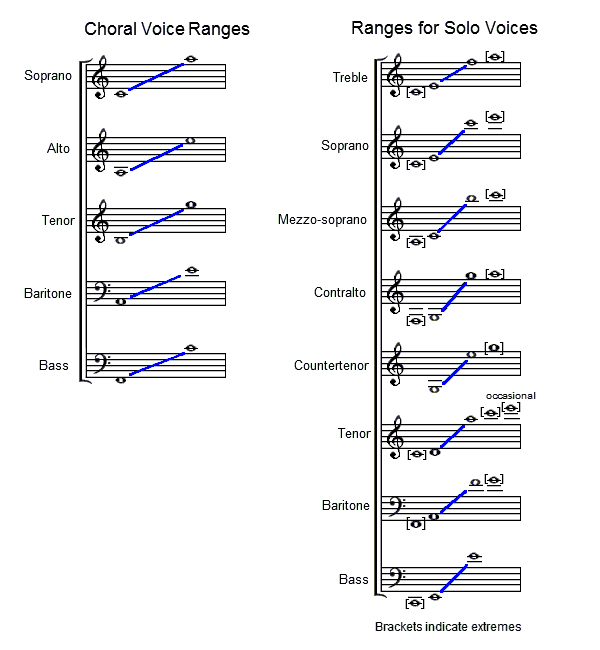
voicing – (1) Adjustment of a piano to obtain a uniform tone quality. This is done by softening or hardening the felt on the hammers that strike the strings by filing down worn felts or replacing them altogether. (2) In musical arranging and orchestration, the process of assigning different notes of a chord or melody to different combinations of instruments or voices. (3) In synthesizers, applying the design of a particular synth to create specific sounds. (4) The equalization and balancing of a speaker and amplifier systems, such as studio monitors or theater sound systems, to optimize the sound reproduction.
vokes – slang for vocals. Although vox and voc are more common abbreviations for vocals, vokes has the advantage of sounding like the first syllable of vocals.
volt (V) – the unit used to measure voltage, the electrical potential between two points in a circuit, equal to the force required to produce a current of one ampere through a resistance of one ohm. The volt is also equal to the ratio of energy per charge of electricity or one joule per coulomb. The volt is named for the Italian physicist Alessandro Volta.
voltage (V) – the potential difference between two points in an electronic circuit between which a flow of electric current can occur, as measured in volts. The potential difference creates electromotive force (EMF), which causes electrons or other charged particles to move between two points. The relationship between the voltage (V), resistance (R), and current (I) is V = IR, which is known as Ohm's Law. The symbol for voltage is sometimes shown as E (for electromotive force).
voltage-controlled amplifier (VCA) – an amplifier that changes gain according to the control voltage it receives.
voltage-controlled crystal oscillator (VCXO) – a type of oscillator used in many digital devices to provide a crystal-stabilized clock source, with the ability to adjust the rate by changing the input voltage. This feature provides the clock the ability to be synchronized to an external clock source like a word clock.
voltage-controlled filter (VCF) – a filter (typically a low-pass filter) that changes its cutoff frequency according to a control voltage sent to it.
voltage-controlled oscillator (VCO) – an electronic oscillator whose output frequency changes according to the control voltage it receives.
voltage level (dBV or dBu) – a measure of voltage as indicated by the logarithm of the voltage relative to a reference value, 1.0 volt RMS (as used in consumer audio, expressed as dBV) or referenced to 0.775 volts RMS, (as used in professional audio, expressed as dBu).
voltage regulator – an electronic circuit that maintains a contant level of voltage in a power supply. A voltage regular reduces or eliminates power surges, spikes, and brownouts that can harm sensitive electronics.
voltage spike – see transient voltage.
voltage trigger – see trigger.
Volta Graphophone Company – see Graphophone and American Graphophone Company.
volt-amperes – see apparent power.
voltmeter – a device that measures the voltage in a circuit.
volts per octave (V/oct) – a method of specifying control voltage (CV) on some analog synthesizers to set pitch, where a given voltage represents a specific octave in the pitch range of the synthesizer and each octave above that increases by 1 volt. The other main way of doing this is called hertz/volt (Hz/v).
volume – (1) A somewhat ambiguous term for the strength of a sound wave as perceived by the human ear. Volume and loudness are often used interchangeably. Although it is often said that the amplitude of a sound wave determines volume, this is only partially true. The perceived loudness varies with frequency (see the Fletcher-Munson effect) and the strength of a sound must increase by a factor of approximately ten to sound twice as loud. For this reason, the amplitude of sound waves are often displayed in decibels. (2) A volume control.
volume control – a device on a radio, amplifier, and other audio devices used to adjust the output level (loudness or volume) of an audio signal.
volume envelope – see envelope.
volume pedal – a device that changes the volume of an instrument, such as a guitar or organ, when stepped on or depressed with the foot.
volume resistivity – see resistivity.
volume unit (VU) – a unit used to measure the perceived loudness of an audio signal as measured with a VU meter. The term volume unit is hardly ever used, only the abbreviation vu, pronounced “vee-you.” In 1939, a reference power level of 1 milliwatt into 600 ohms was established so that 0 vu equalled 0 dBm for a pure 1000-Hz sine wave, but it never became standard. Rather the level is generally calibrated according to one of several industry quasi-standards. Most commonly 0 VU represents a voltage level of +4 dBu or about 1.23 volts RMS. Some manufacturers such as Mackie calibrate their meters so that 0 VU equals 0 dBu. Others use -10 dBV, about 0.32 volts, for 0 VU. In the broadcast industry, line level is considered to be +8 dBu, so they set their VU meters to that value. Although the abbreviation is often shown as VU, the correct designation is lower case vu.
Vorbis – see Ogg Vorbis.
vortal – an internet site with a directory of links to information related to a particular industry. The term is a combination of vertical (as in vertical industry) and portal.
VOTT – Voice Of The Theater.
VOX – Voice Operated eXchange. A feature originally used on some tape recorders that automatically started recording when speech began and stopped when silence occurred. Today some cell phones and other devices use this process to extend battery life. Also called voice operated relay.
vox – abbreviation for vocal or voice. (Vox is Latin for voice). Sometimes designated as voc.
Vox Amplification, Ltd. – a company founded in Dartford, Kent, UK, that manufactures guitar amplifiers, electric organs, and other musical instruments. Vox was acquired by Korg in 1992.
VOXX International – an consumer electronics company founded by John J. Shalam in 1965 as Audiovox Corporation. Headquartered in Hauppauge, New York, the company changed its name to VOXX International in 2012. It specializes in automotive electronics, consumer electronics, and consumer and professional audio equipment. Its US brands include Audiovox, Acoustic Research, Advent, Jensen, Klipsch, Prestige, RCA, Terk, and others. Its international brands include Hirschmann, Heco, Oehlbach, Magnat, Schwaiger, and others.
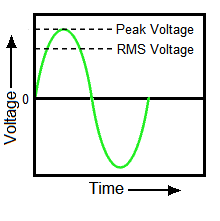
VRMS – RMS Voltage. Voltage as measured by the root mean square (RMS), the square root of the mean of the squares of the values, for the one time period of the sine wave. Compare with peak to peak voltage which is measured between the maximum positive and negative amplitudes of the sine wave. Sometimes written as Vrms.
VR – Virtual Reality.
VR audio – sound for use with virtual reality (VR) experiences. While a “head-locked” environment (one in which the soundscape does not move when the head moves) is fine in a movie theatre, it does not work well for a virtual reality experience. You want a virtual world to be like the real world. For example, if you hear a bird singing in a tree to your left, you should hear that sound coming from the left, but if you turn your head to look at the bird, the sound should shift to be in front of you. For that reason VR uses something called 3D Spatial Audio. If done correctly, 3D spatial audio should convincingly place sounds in a three-dimensional space so that the user perceives the sounds as coming from the real physical objects in their VR experience.
VSIF – Video Services Industry Forum. See Video Services Forum.
VSF – Video Services Forum.
VST – Virtual Studio Technology. (1) A plug-in format introduced in 1996, developed and licensed by Steinberg for integrating plug-ins with digital audio workstations (DAWs). The VST format has become somewhat of a standard that allows third-party developers to create plug-ins that can be used on a variety of DAWs that use the format. There are two main types of VSTs: (a) effects, sometimes designated as VSTfx and (b) instruments, designated as VSTi. (2) Plug-ins that use the VST format.
VST2 – an update to the VST plug-in standard introduced in 1999, that made a number of improvements to the original VST format.
VST3 – an update to the VST plug-in standard, introduced in 2008, which completely rewrote the code and introduced a number of new features, including 64-bit audio data processing.
VST3.5 – an update to the VST plug-in standard, introduced in 2011, which added new improvements including additional instrument capabilities.
VSTfx – VST Effects. See VST.
VSTi – VST Instruments. A VST format to generate audio using virtual synthesizers or samplers. Some of these are designed to emulate the look and sound of famous hardware synthesizers. A regular VST plug-in generally is used to create effects and is sometimes designated as VSTfx.
VTR – VideoTape Recorder.
V-trig – short for voltage trigger. See trigger.
VTVM – Vacuum Tube Volt Meter.
vu – Volume Unit.
VUK – a VU meter using K-weighting. K-Metering is used to comply with the ITU loudness mode (ITU BS.1770), as K-weighting more closely follows the sensitivity of the human ear to different frequencies.

VU meter – a meter used to measure audio levels that match the response of the human ear, as indicated by the volume unit (vu). The VU meter was developed in the late 1930s jointly by Bell Laboratories, CBS, and NBC. It was designed so that the response approximated the response of the human ear to complex audio waveforms, with readings that are between the peak and average values. The standards for the VU meter specify the meter ballistics (how fast the needle responds to various signals) and the frequency response. Although many inexpensive meters are marked in vu, they do not meet these standards. The VU meter was never used much in Europe, where peak meters were generally preferred. For the most part VU meters have been replaced by segmented LED level meters in audio equipment today, or in the case of DAWs, graphical representations of segmented meters.
Note: We believe this is the largest dictionary (glossary) of terms specific to usage within the recording industry that is currently available on the internet, with more than 8,800 entries, nearly 800 illustrations, and dozens of tables. Some of the terms have different or additional meanings in other situations, especially within the electronic, automotive, scientific, and computer industries. Of necessity there are obvious overlaps into other fields such as music, electronics, and computers, but such excursions are limited to information deemed pertinent to the knowledge required to operate and/or participate effectively in the workings of a recording studio. Also included are terms related to sound reinforcement (live performances) including wireless microphone technology because a working knowledge of that terminology is necessary for recording at live performance venues. Because recording studios also record audio for video and motion pictures (films), some terminology from those fields is included. Some scientific terms are included because they help explain studio terminology. For example, electromagnetism explains how microphones, loudspeakers, and guitar pickups work. Knowledge of radio waves and the radio frequency spectrum is needed to explain wireless devices. Any trademarks or trade names mentioned belong to their respective owners. The information contained in this dictionary is believed to be accurate at the time of publication. This information is subject to change without notice. The information was obtained from and cross-checked with a variety of sources that are believed to be reliable. However, Los Senderos Studio, LLC does not guarantee the accuracy or completeness of the information contained herein. Please contact us to report any errors, omissions, discrepancies, or broken links. Los Senderos Studio shall not be responsible for any consequences or damages arising out of the use of this information. Nothing in this glossary should be interpreted as legal advice. For a glossary providing information on legal and business matters for musicians, we suggest you consult Musicians Business Dictionary.
A note on alphabetical order: The terms in this glossary are alphabetical without regard to spaces and punctuation. For example, AM Radio follows amplitude. While this may seem to be at odds with other conventions, it eliminates confusion with words such as pickup, which is sometimes written as pick up or pick-up. In addition, all symbols such as &, -, or / are ignored. The entries on the number page (0-9) are listed in increasing value within each digit. For example, all of the entries beginning with 1 are listed before those starting with 2. For Greek letters (α-ω), the entries are in Greek alphabetical order.


